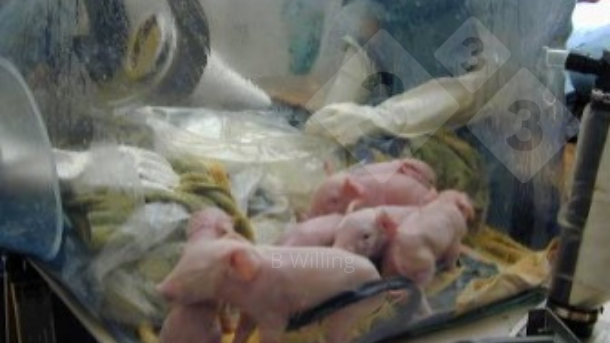Just like for COVID 19, one of the best ways to protect pigs from disease is through vaccination. However, also similar to the COVID 19 vaccine, vaccines for pigs are not 100% effective at generating a protective immune response in every animal receiving it, thus leaving some vaccinated animals vulnerable to disease. We have found that even within a high health herd, vaccine specific antibody titers can vary by more than 100 times between animals of the same age and weight (Munyaka et al. 2019). With the intent of finding ways to increase the efficacy of vaccinations, our group and others are trying to understand why vaccine response varies so much between animals and are exploring the expression of genes in the blood as well as the population of microbes found in the gastrointestinal tract that might explain this variation.
In two distinct pig populations in Canada and France, we have found that the microbial population measured in the feces of the pig is more predictive of how that pig will respond to vaccination than the expression of genes in the blood immune cell population at the time of vaccination (Munyaka et al. 2019, Munyaka et al. 2020). While the microbial communities in Canadian and French pigs were very different, we did find common microbes that were associated with higher antibody titers (considered favorable), and low antibody titers (considered deleterious). Some of the microbes associated with lower antibody responses were not surprising, such as Clostridium perfringens, as it is a known cause of enteritis in pigs. The bacterial genus most associated with increased antibody titers in both the Canadian and French pigs was Prevotella. The positive association was not found for all Prevotella species, but the vast majority of Prevotella were associated with better antibody production. It has yet to be determined whether the Prevotella are indeed causing a better immune response, or whether their increased presence is an indicator of a pig's health, however, there are also human studies suggesting that increased carriage of Prevotella supports an appropriate immune response. For example, increased levels of Prevotella in pregnancy were associated with protection against allergy in the resulting children (Vuillermin et al. 2020). Future work is now needed to test the causal role Prevotella might play in shaping the pig immune system. This work will have to start with isolation of this strictly anaerobic organism as there are very few pig Prevotella that have been isolated. Our team has now generated a few isolates using anaerobic culture techniques, however, we still need to test how these bacteria shape the immune response. This will be achieved by colonizing pigs reared in germ free bubbles and using controlled microbial exposures (Figure 1).


One of the key findings beyond the microbes that were associated with vaccine response was a question of timing. While the bacterial community at the time of vaccination was predictive of antibody titers several weeks after vaccination, the bacterial community that coincided with the time of the antibody titers was no longer predictive (Munyaka et al. 2020). This suggests that there is a critical role of the early life microbial community in shaping the development of the pig (Marcolla et al. 2019)
One last important finding from this study dispels a common misconception. Many people thought that the higher responders might be putting too much energy into the immune response and generating antibodies, and thus have reduced growth rates. The findings of this study found the opposite, and that the microbes that positively associated with antibody titers were also positively associated with growth. Once we have confirmed the role of these microbes in supporting immune response and performance, we will then need to figure out how to put these microbes to work.





